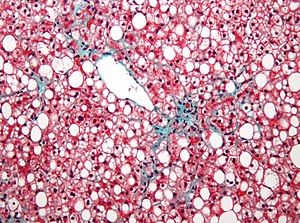Nonalcoholic fatty liver disease
| Non-alcoholic fatty liver disease | |
|---|---|
 |
|
| Micrograph of non-alcoholic fatty liver disease, demonstrating marked steatosis (fatty liver appears white). Trichrome stain | |
| Classification and external resources | |
| Specialty | Gastroenterology |
| ICD-10 | K76.0 |
| ICD-9-CM | 571.8 |
| DiseasesDB | 29786 |
| eMedicine | med/775 |
Non-alcoholic fatty liver disease (NAFLD) is one of the types of fatty liver which occurs when fat is deposited (steatosis) in the liver due to causes other than excessive alcohol use. NAFLD is the most common liver disorder in developed countries.
NAFLD is related to insulin resistance and the metabolic syndrome and may respond to treatments originally developed for other insulin-resistant states (e.g. diabetes mellitus type 2) such as weight loss, metformin, and thiazolidinediones. Up to 80% of obese people have the disease.Non-alcoholic steatohepatitis (NASH) is the most extreme form of NAFLD, and is regarded as a major cause of cirrhosis of the liver of unknown cause. Most people have a good outcome if the condition is caught in its early stages.
About 12 to 25% of people in the United States has NAFLD. While NASH affects between 2 to 5% of people in the United States.
Most people with NAFLD have few or no symptoms. Patients may complain of fatigue, malaise, and dull right-upper-quadrant abdominal discomfort. Mild jaundice may be noticed although this is rare. More commonly NAFLD is diagnosed following abnormal liver function tests during routine blood tests. By definition, alcohol consumption of over 20 g/day (about 25 ml/day of net ethanol) excludes the condition.
NAFLD is associated with insulin resistance and metabolic syndrome (obesity, combined hyperlipidemia, diabetes mellitus (type II), and high blood pressure).
...
Wikipedia
